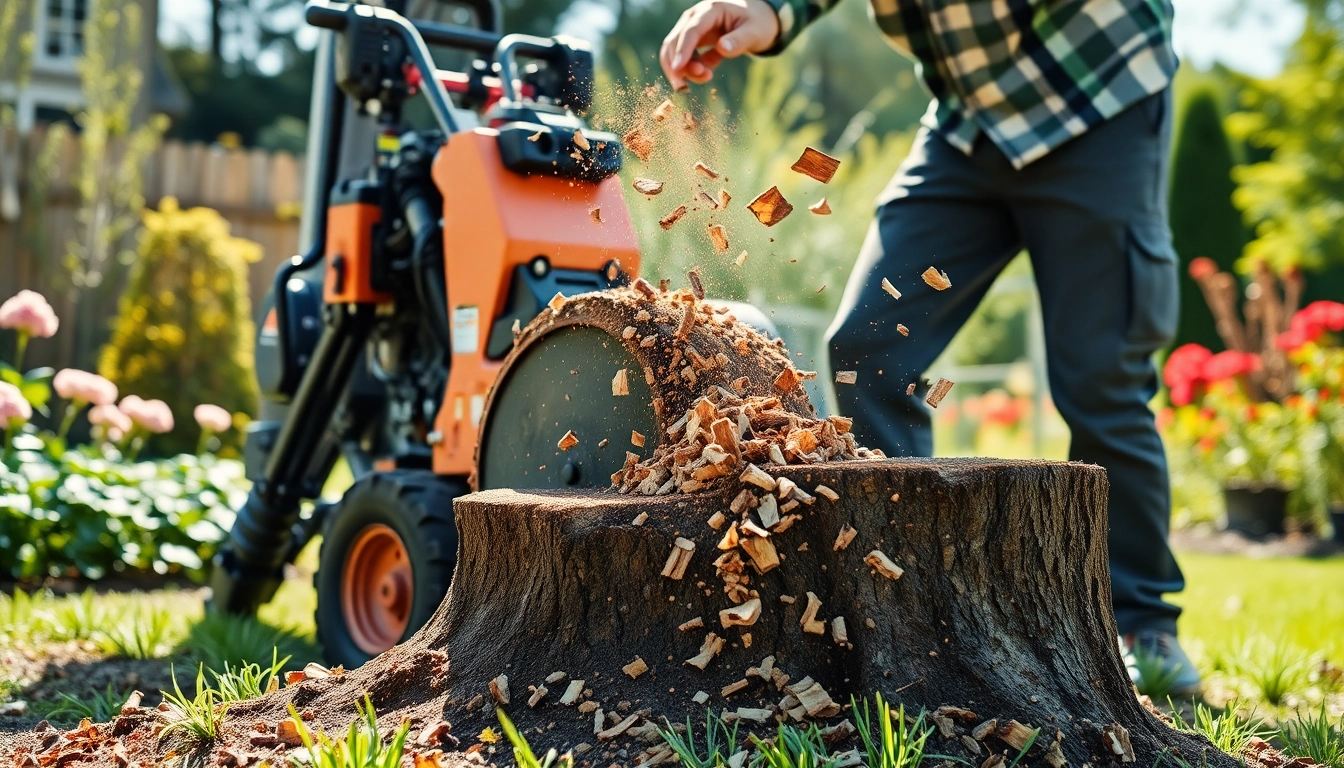Expert Stump Grinding Service to Revitalize Your Landscape
Understanding Stump Grinding Services
What is Stump Grinding?
Stump grinding is a process that involves the removal of tree stumps after a tree has been cut down. It employs specialized machinery that grinds the stump into small wood chips, effectively eliminating any remaining parts above ground and a portion below the soil surface. This method is preferred over stump extraction as it minimizes disruption to the surrounding landscape and is often more efficient. The main machinery used in stump grinding is a stump grinder, which can come in various sizes for different scales of operation, ranging from portable, walk-behind models to larger, truck-mounted units.
Benefits of Professional Stump Grinding
There are numerous advantages of hiring professionals for stump grinding service. First, professionals possess the right equipment, which optimally performs the job, ensuring safety and efficiency. They have expertise in assessing the situation, understanding the best approach to take based on stump size, location, and surrounding flora. Additionally, professional services often include thorough cleanup, which can save property owners both time and hassle. Moreover, stump grinding prevents potential pests, reduces the chances of diseases from decaying wood, and enhances property aesthetics.
Common Situations Requiring Stump Grinding Services
Stump grinding services may be required in various circumstances. Urban areas, where space is limited, often necessitate the removal of stumps to avoid hazards and free up space for landscaping or construction. Similarly, when trees are diseased or damaged, stump grinding can help prevent the spread of infection to healthy plants in proximity. Property owners may also wish to grind stumps simply for aesthetic reasons, especially in residential or commercial landscapes where the appearance of the yard is critical. Lastly, stumps may obstruct mowing or other landscaping activities, making stump grinding an essential service for property maintenance.
The Stump Grinding Process
Preparation for Stump Grinding
Before commencement, adequate preparation is key to a successful stump grinding operation. This includes assessing the location and ensuring that all obstacles, such as garden beds, fences, or power lines, are cleared from the vicinity. Professionals will evaluate the stump size and species of the tree as certain types of wood may react differently during grinding. It’s crucial to discuss any concerns with your service provider; they should also inquire if there are any underground utilities that must be avoided, as hitting these could lead to significant problems and expenses.
Step-by-Step Stump Grinding Techniques
The stump grinding process generally follows a series of steps to ensure efficiency and safety:
- Initial Assessment: Evaluate the stump, measuring its height and width to determine appropriate machinery and plans for disposal.
- Clearing the Area: Remove any potential hazards around the stump, including rocks, debris, and vegetation that may interfere with the grinding process.
- Positioning the Grinder: Place the grinder in a stable location, ensuring it is positioned securely for maximum impact on the stump.
- Grinding: The grinder will be operated to directly chip away at the stump, starting at the top and gradually working downwards, turning the wood into mulch.
- Depth Adjustment: The operator may adjust the depth of the grinder to ensure all parts of the stump are adequately ground below the surface.
- Cleanup: Post-grinding, the area will be cleaned of excess mulch and debris, leaving the site ready for further landscaping or restoration.
- Disposal: Decide what to do with the resulting wood chips, whether reusing them as mulch or disposing of them in yard waste.
Post-Grind Cleanup and Safety Measures
After the stump is ground successfully, a thorough cleanup is essential to leave the area tidy and prevent accidents. All excess mulch should be collected and cleared from the site. Also, during the grinding, safety is paramount: operators should wear protective gear such as helmets, goggles, and ear protection due to the equipment’s noise levels and flying debris. Homeowners should maintain a safe distance during the grinding process to avoid any potential hazards.
Choosing the Right Stump Grinding Service Provider
What to Look For in a Service
Selecting the right stump grinding service provider requires careful consideration. Look for a company that has a good reputation and positive customer reviews. It’s beneficial to choose a service with certified and experienced personnel who understand the intricacies of stump grinding and landscape management. Verify that the service provider carries adequate insurance to protect against any potential damages or accidents during the operation.
Questions to Ask Before Hiring
Before finalizing your decision, consider asking potential providers the following questions:
- What experience do you have in stump grinding?
- Are your technicians insured and licensed?
- Can you provide references or reviews from previous customers?
- What safety measures do you take during the grinding process?
- What services do you offer beyond stump grinding, such as landscaping or tree removal?
- What are your timelines for completing the job?
Understanding Service Costs and Estimates
The cost of stump grinding can vary significantly based on several factors, including stump size, location, and the complexity of the job. Service providers may charge either a flat rate or an hourly rate, and obtaining multiple estimates is advisable to ensure competitive pricing. Some companies may also factor in additional costs for cleanup or removing the mulch produced during the grinding process. Understanding what is included in the estimate can help avoid any unexpected costs.
DIY Stump Grinding vs. Professional Services
When to Consider DIY Stump Grinding
While professional stump grinding services offer many benefits, some property owners may consider a DIY approach for minor stumps. If the stump is small or located in a picturesque area, utilizing a simpler, consumer-grade grinder could be a viable option. However, it’s important for DIY enthusiasts to understand their own physical limitations and the scale of machinery required for the job.
Pros and Cons of Professional Stump Grinding Services
Opting for professional stump grinding comes with distinct advantages:
- Expertise: Trained professionals understand how to manage the grinding process effectively, leading to better outcomes.
- Safety: Professionals come equipped with safety gear and knowledge of safe practices, reducing risk.
- Efficiency: A professional service will typically complete the task faster and with less disruption to your landscape.
- Cleanup: Removal of debris and wood chips is usually included, saving time for the homeowner.
However, potential downsides include higher costs compared to DIY methods and the need to coordinate schedules with service providers.
Essential Tools for DIY Stump Grinding
If you consider a DIY approach, certain tools and equipment are necessary, including:
- Stump Grinder: Depending on the size of the stump, you may need either a handheld unit or a heavy-duty machine.
- Protective Gear: Safety goggles, gloves, and ear protection are essential for ensuring personal safety.
- Shovels and Rakes: Useful for clearing debris prior to grinding and for cleanup afterward.
- Mulch Blower: If you plan to reuse the mulch, a blower can be handy for spreading it evenly over the ground.
Maintaining Your Landscape Post-Stump Grinding
Ground Restoration Techniques
Once the stump grinding is finished, ground restoration is crucial for maintaining a healthy landscape. The area where the stump was removed will often need soil amendments. Filling in the resulting hole with high-quality topsoil helps level the ground, while adding organic matter can improve nutrient availability for surrounding plants. Consider planting grass or ground cover plants to encourage stabilization of the soil and aesthetic appeal.
Planting in Stump-Grinded Areas
For homeowners wishing to plant in areas where stumps have been ground, it’s essential to wait for the wood chips to decompose fully, as they can absorb nitrogen from the soil and affect the growth of new plants. Once decomposition is complete, considering plants that thrive in decomposing soils can be advantageous; however, it’s best to choose native plants that require less maintenance and are more drought-resistant.
Long-term Benefits of Professional Stump Grinding Service
The long-term benefits of professional stump grinding extend beyond the immediate visual improvement of the landscape. It enhances soil health by allowing for better air and water penetration. A clean stump removal can also discourage pests and diseases in your yard, contributing to overall plant health. Furthermore, stump grinding promotes the efficient use of space, allowing property owners to redesign their landscaping altogether. As a result, effective land management through stump grinding can lead to increased property value and improved aesthetics both for personal enjoyment and potential marketability.














Post Comment